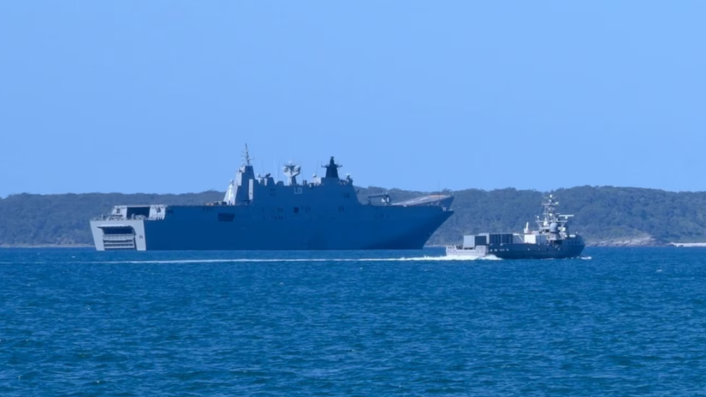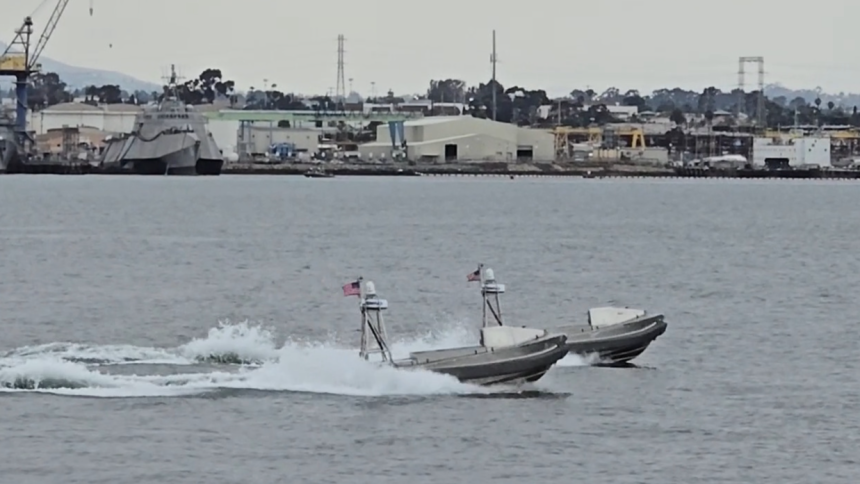Swarms of attritable and networked USVs, loitering munitions, and missiles can stall, pin down, and cause maximum damage to a Chinese naval force, buying time to amass forces for a counterattack.
Nearly one-and-a-half month after The Aviationist reported Taiwan’s Ukraine-inspired kamikaze drone boat meant to pose an asymmetrical challenge to the Chinese navy, reports from Taiwan have quoted U.S.-based experts and military leaders who have underscored the need for focusing on attritable, asymmetric platforms.
Effectively validating Taiwan’s ODC (Overall Defense Concept) that has been at the center of debate among the island’s leadership, the experts also name U.S. Navy programs like Hellscape and Replicator which envisage thousands of sea and aerial drones that can slow down or even defeat a Chinese invasion force. The reports, however, do not mention the ODC or its natural synergy with Hellscape or Replicator.
The experts called for hundreds of low-cost unmanned, semi-autonomous/autonomous USVs, UAVs and mass manufactured, modular missiles, loitering munitions, EW (Electronic Warfare) sensors and jammers as the type of weapons required for fending off or stalling a Chinese invasion.
Taiwan unveiled an unmanned surface vessel (USV) inspired by Ukraine’s use of similar boats in the Black Sea.
The USV is designed to be autonomous and has a range of potential uses, including mine clearance and potentially even kamikaze attacks. pic.twitter.com/cHhVsyiWXK
— Clash Report (@clashreport) June 5, 2024
While the report did not mention the ODC, the doctrinal and tactical thinking is the same – to stall, pin down and cause maximum damage to a naval force and buy time to work out the logistics and forward-basing to amass forces for a counterattack with larger capital weapons. Nevertheless, it does mark a convergence of military thinking between US and Taiwanese planners.
Hellscape and Replicator
CNA quoted the INDOPACOM (Indo-Pacific Command) chief Admiral Samuel Paparo’s interview with The Washington Post in Jun. 2024, where he mentioned the Hellscape program. “The U.S. military would deploy thousands of unmanned submarines, unmanned surface ships and aerial drones to flood the area and give Taiwanese, U.S. and partner forces time to mount a full response,” mentioned the Admiral about the program. “The idea is to make their lives utterly miserable for a month, which buys me the time for the rest of everything.”
Prior to that in March, the DoD (Department of Defense) announced it would spend $1 billion on the Replicator program, building swarms of USVs and drones for this very mission. Paparo said the Replicator program “shows that the United States is also learning lessons from the Russia-Ukraine war, where Ukraine has innovated with drone technology.”
The CNA report then quoted former USN officer Bryan Clark and a Senior Fellow at the Hudson Institute who said that these USN drones could be based in the Philippines and Japan. Clark added that the USN Navy could glean valuable lessons from Ukraine’s success against Russia’s Black Sea Fleet. In fact, despite a limited naval presence, Ukraine managed to push Russian forces eastward, securing shipping lanes and enabling attacks on Crimea.

Taiwan’s geography is particularly suited for drone warfare, Clark points out. The narrow Taiwan Strait and limited landing sites create a bottleneck, allowing drones to disrupt or halt a Chinese invasion fleet. This is similar to Ukraine’s Black Sea tactics and the Houthis’ use of drones in the Red Sea. Clark believes these sea drones could act as autonomous mines, simplify logistics, as well as serving as decoys with sensors and targeting algorithms to function even with jamming attempts by Chinese forces.
Existing US naval drone programs
The USN however has ongoing experimental and commissioned unmanned programs. In 2022, the service established the USVDIV One (Unmanned Surface Vessel Detachment One) made up of the prototypes Sea Hunter, Sea Hawk trimaran-type boats and the Ranger and Mariner medium-sized vessels.
While the first two-were were purpose-built for the role, the Ranger and Mariner were modified for the role from cargo and support ship design configurations. At a broader level, they are a part of the Ghost Fleet Overlord program, fitting into the even larger DMO (Distributed Maritime Operations) concept. The Ranger and Mariner have exercised with American and Japanese vessels as detached carriers of ammunition and weapons release platforms.
27 SEP, JS KUMANO conducted a Japan-U.S. bi-ex with USS Oakland, USV (Unmanned Surface Vehicle) Ranger and USV Mariner in Sagami Bay to improve its tactical capability and interoperability with the USN.
It was the first exercise with USV for the JMSDF. #FOIP pic.twitter.com/6U6BHrCpOh
— JMSDF Self-Defense Fleet ENG (@JMSDF_SDF_ENG) September 29, 2023
In September 2021, the USN test fired an SM-6 missile from the Ranger using a modular launcher. The USN also has the USVRON 3 (Unmanned Surface Vessel Squadron 3) that operate the GARC (Global Autonomous Reconnaissance Craft).
US Navy’s unmanned Ghost Fleet ship USV Ranger fires an SM-6 missile,now no country has installed long-range air defense missiles on USVs. pic.twitter.com/grR2YxMdCk
— Caesar (@Ninja998998) October 19, 2021
Challenges
Potential obstacles to the Replicator and Hellscape programs include diplomatic issues, such as the difficulty of getting Allied countries like the Philippines or Japan to allow the US military bases in their countries to be used against China. Even trickier would be getting them to directly intervene and participate in operations. This is because both scenarios would make their territories legitimate targets for Chinese strikes.
Secondly, the delivery timelines for the swarm drones are also far from being finalized, since the programs have been announced only recently and are still to enter the serial production stage. Not to mention the persisting problems in the US defense industrial base which will take years to replenish the ordnance donated to Ukraine from its own stockpile.
Lastly, China too is advancing rapidly, with proven kinetic, capital and asymmetric weapons, unmanned technologies, along with notable cyber and electronic warfare capabilities, backed by a stable industrial base. It would be reasonable to expect that its achievements in the electromagnetic spectrum will have evolved to match the autonomous drone swarm capabilities the West puts before it.









